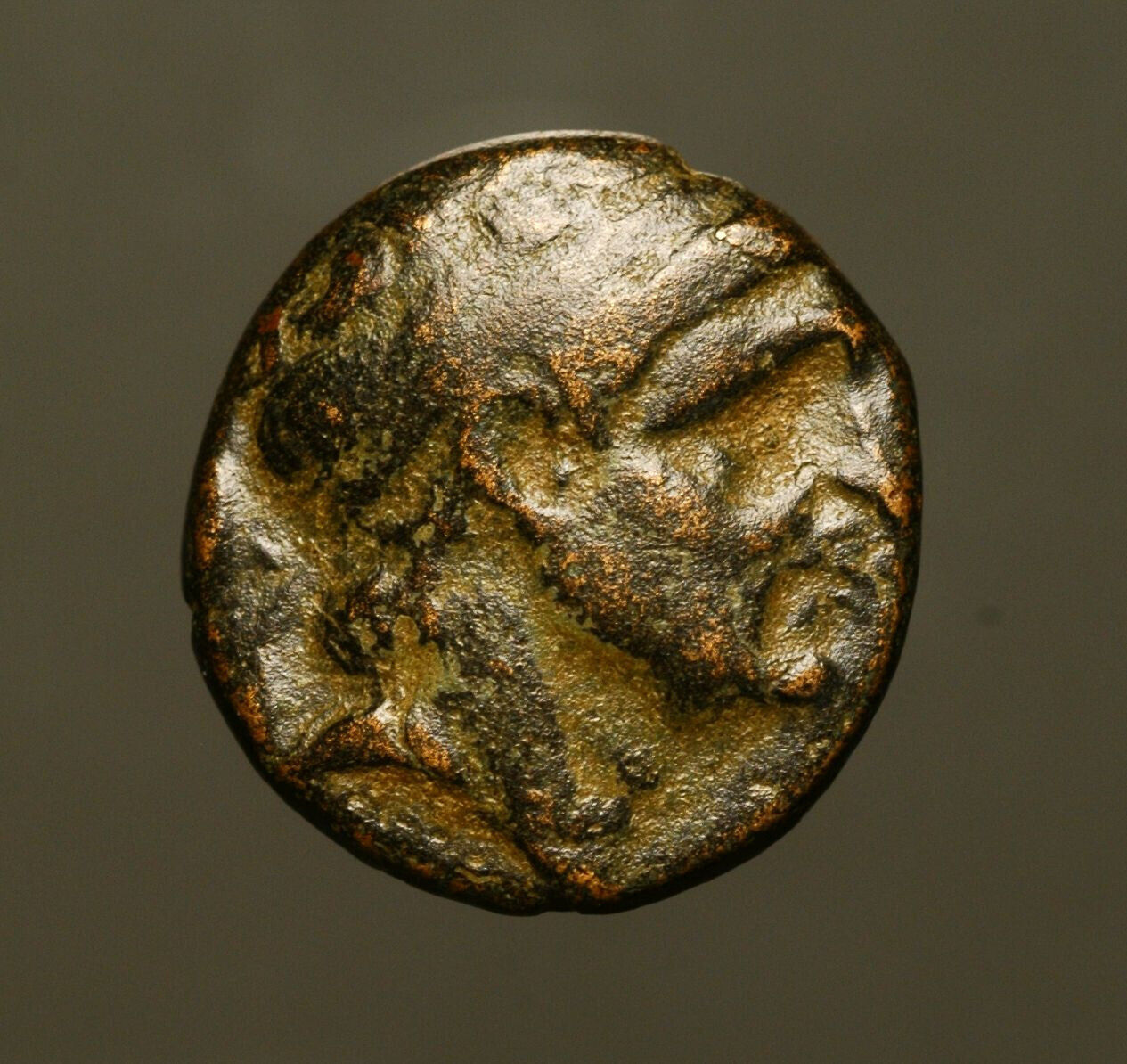-40%
Ancient Greek Coin/Sicily/Syracuse/Apollo/Pegasus/Timoleon/Race Torch
$ 21.64
- Description
- Size Guide
Description
For sale please find an authentic ancient Greek drachm from Sicily in Syracuse. Material: Bronze; Denomination: Drachm; Mint: Syracuse, Sicily; Year Made: 337-317 BCE; Size: 17 mm; Weight: 5 grams; Obverse: Laureate head of Apollo left; race torch behind head - ΣYΡAKOΣIΩN off flan. Reverse: Pegasus flying left; NI below. References: Calciati #85; SNG ANS #646; Hoover HGC #1486.Timoleon (Greek: Τιμολέων), son of Timodemus, of Corinth (c. 411–337 BC) was a Greek statesman and general. As a brilliant general, a champion of Greece against Carthage, and a fighter against despotism, he is closely connected with the history of Sicily, especially Syracuse.
Timoleon was a member of the Corinthian oligarchy. In the mid 360s BC, Timophanes, the brother of Timoleon, took possession of the acropolis of Corinth and effectively made himself tyrant of the city. In response, Timoleon, who had earlier heroically saved his brother's life in battle, and after repeatedly pleading with him to desist, became involved in the assassination of Timophanes. Most Corinthians approved his conduct as patriotic; however, the tragic occurrence, the actual fratricide, the curses of his mother, and the indignation of some of his fellow citizens, drove him into a self-imposed early withdrawal from politics and civic life for twenty years.
Because of inner strife, the depredations and decline in Syracuse caused by the despots Dionysius and his son who succeeded him, and because of the repeated conflicts with powerful Carthage, a group of Syracusians sent an appeal for help to Corinth, their mother city, which reached that city-state in 344 BC. Corinth agreed to help, but her chief citizens declined to accept the seemingly hopeless task of establishing a stable government in, tyrannical, fractious, insecure, and turbulent Syracuse.
Timoleon, being named by an unknown voice in the Corinthian popular assembly, was chosen by a unanimous vote to undertake the mission. He set sail for Sicily with seven ships, a few of the leading citizens of Corinth, and a small force of 700 Greek mercenaries. He eluded a Carthaginian squadron by an ingenious stratagem and landed at Tauromenium (now Taormina) in 344 BC, where he met with a friendly reception. At this time Hicetas, tyrant of Leontini, was master of Syracuse, with the exception of the island of Ortygia, which was occupied by Dionysius II, still nominally ruler.
Hicetas was defeated by Timoleon at Adranum, an inland town, and driven back to Syracuse. After his initial, unexpected success, Timoleon was sent reinforcements from Corinth and some north-western Greek states. Following the siege of Syracuse, Dionysius II surrendered Ortygia in 343 BC on the condition of his being granted a safe conduct to Corinth, where he ended his life as a private, well-off, citizen.
Hicetas now received help from Carthage (60,000 men), but ill-success roused mutual suspicion; the Carthaginians abandoned Hicetas, who was besieged in Leontini, and who was then compelled to surrender. Timoleon was thus master of Syracuse.
He at once began the work of restoration, beginning with the symbolic act of destroying the citadel constructed and used by the tyrants to oppress the people of Syracuse, and replacing it with a court house. He brought new settlers to depopulated Sicily from all over Greece, and re-established a popular government on the basis of the democratic laws of Diocles. The amphipolos, or priest of Olympian Zeus (ἀμφίπολος Διὸς Ὀλυμπίου), who was chosen annually by lot out of three clans, was invested with the chief magistracy. The impress of Timoleon's reforms seems to have lasted to the days of Augustus.
Hicetas persuaded Carthage to send (340–339 BC) a great army (70,000 men), which landed at Lilybaeum (now Marsala). With a miscellaneous levy of about 12,000 men, most of them mercenaries, Timoleon marched westwards across the island to the neighborhood of Selinus. Against all odds, after being deserted by a part of his army who believed that facing a foe six times as large as their own was hopeless, Timoleon, at the head of his infantry, won a great and decisive victory on the Crimissus. His victory was made possible by the fact that the Carthaginian army had not yet completed the river crossing so his small force only had to fight the elite part of the Carthaginian force. He was also aided by a violent storm at the backs of his troops but blinding to the Carthaginians.
Later, Carthage dispatched mercenaries to prolong the conflict between Timoleon and the Greek tyrants. But this ended in the defeat of Hicetas, who was taken prisoner and put to death. A treaty in 338 BC was agreed upon, by which Carthage was confined in Sicily to the west of the Halycus (Platani) and undertook to give no further help to Sicilian tyrants. Most of the remaining tyrants were killed or expelled. This treaty gave the Greeks of Sicily many years of peace, restored prosperity, rule of law, and safety from Carthage.
U.S. buyers will pay .45 for first class shipping. If you are not in the United States please know that I use eBay's Global Shipping Program which means if you win the item, eBay bills you and once you pay they pay me and give me the go-ahead to ship the item to their distribution facility in Kentucky. Please note, I have nothing to do with any of the shipping charges eBay bills you for including IMPORT FEES. It is not my call. Contact them if you have questions. I will not ship overseas any other way. It really is a hassle. Sorry.










